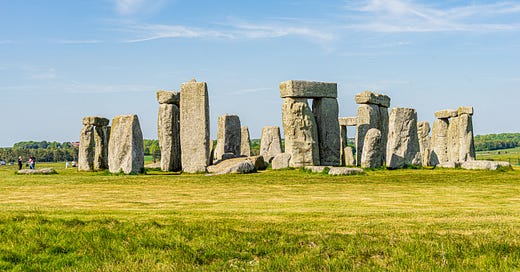Nestled in the vast Salisbury Plain of Wiltshire, England, stands one of the world's most enigmatic and iconic ancient structures — Stonehenge. For centuries, this prehistoric monument has captivated the imaginations of historians, archaeologists, and curious minds alike, giving rise to countless theories about its purpose and origin.
The Stones
At the heart of Stonehenge are massive standing stones, arranged in a circular pattern with a designated horseshoe-shaped structure within. These monoliths, some reaching a height of over 20 feet and weighing several tons, are a testament to the engineering prowess of the ancient builders. The most famous stones, known as sarsens, are of local origin, while the smaller bluestones are believed to have been transported from the Preseli Hills in Wales, over 150 miles away.
The construction of Stonehenge remains a fascinating marvel, with experts suggesting that it unfolded in several phases between 3000 BCE and 2000 BCE. The transportation of massive stones over long distances, the precise shaping of the stones, and the alignment accuracy all seem to indicate the advanced knowledge and organizational skills of its builders.
Astronomical Alignment
One of the most interesting aspects of Stonehenge is its apparent astronomical alignment. The monument's axis aligns with the summer and winter solstices, leading many to believe that it served as an ancient celestial observatory or a primitive calendar. During these solstices, the rising and setting sun aligns perfectly with specific stones, casting a magical glow on the site.
The exact purpose of Stonehenge has sparked numerous theories. Some suggest it was a healing center, while others believe it had connections to ancient rituals and served as a meeting place for different tribes. The absence of written records from the time has only deepened the mystery, leaving room for speculation and imagination.
Recognition and Legacy
Stonehenge's cultural and historical significance led to its designation as a UNESCO World Heritage Site in 1986. Since then, efforts to preserve and study the monument have continued, with advancements in archaeological techniques shedding new light on its history. The site has become a symbol not only of ancient mysteries but also of the everlasting connection between humanity and its past.
Stonehenge stands as a structure that continues to spark wonder and fascination, a silent witness to the passage of time. While the exact purpose of this ancient monument remains a mystery, its mere presence serves as a reminder of the eternal quest for understanding our shared human history and the mysteries that lie beneath the surface of the ancient stones.




